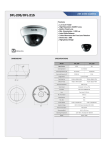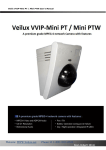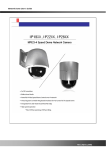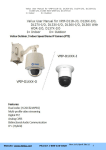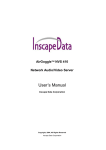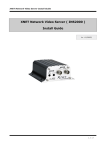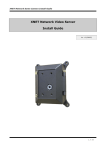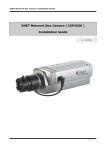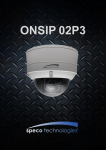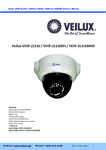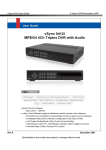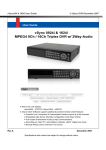Download CNB Technology G1810PF
Transcript
XNET Network Box Camera User’s Guide XNET Network Box Camera User’s Guide Ver. 1.0 (070918) 1 of 47 XNET Network Box Camera User’s Guide Directions This product is designed for indoor use only. When using this camera at outdoors or in an environment that exceeds the limited range, you must separately use a water-resistant case. Be careful not to cause any physical damage by dropping or throwing the unit. Especially keep the device out of reach from children. Do not disassemble this camera. You will be excluded from After Service when disassembled. Use only the power adapter provided with this product. If you would like to use this camera for security, monitoring, please check the legal regulations within the country. Note This equipment has been tested and found to comply with the limits for a Class A digital device, pursuant to part 15 of the FCC Rules. These limits are designed to provide reasonable protection against harmful interference in a residential installation. This equipment generate, uses and can radiate radio frequency energy and, if not installed and used in accordance with the instructions, may cause harmful interference to radio communications. However, there is no guarantee that interference will not occur in a particular installation. If this equipment does cause harmful interference to radio or television reception, which can be determined by turning the equipment off and on, the user is encouraged to try to correct the interference by one or more of the following measures: z Reorient or relocate the receiving antenna. z Increase the separation between the equipment and receiver. z Connect the equipment into and outlet on a circuit different from that to which the receiver is connected z Consult the dealer or an experienced radio/TV technician for help. Caution Any changes or modifications in construction of this device which are not explicitly approved by the party responsible for compliance could void the user’s authority to operate the equipment. This appliance and its antenna must not be co-located or operating in conjunction with any other antenna or transmitter. A minimum separation distance of 20 cm must be maintained between the antenna and the person for this appliance to satisfy the RF exposure requirements. 2 of 47 XNET Network Box Camera User’s Guide Table of Contents 1. Introduction.......................................................................................................................................... 4 1.1. Overview .................................................................................................................................. 4 1.2. Features of XNET/XNET-Wireless ...................................................................................... 4 1.3. Applications of XNET/XNET-Wireless ................................................................................ 4 2. Product Description ............................................................................................................................. 5 2.1. Contents ................................................................................................................................... 5 2.2. Preview ..................................................................................................................................... 5 2.3. Physical Description .............................................................................................................. 6 2.4. PC Requirements ................................................................................................................... 9 2.5 Quick Installation Guide ........................................................................................................ 9 3. Connecting XNET/XNET-Wireless to the Network .......................................................................... 12 3.1. Connecting to LAN ............................................................................................................... 12 3.2. Connecting to xDSL/Cable Modem ................................................................................. 13 4. IP-Installer.......................................................................................................................................... 14 4.1. Main window of IP-Installer .............................................................................................. 14 5. Configuring XNET in Administrative Mode ...................................................................................... 15 5.1. Log On .................................................................................................................................... 15 5.2. Basic Setup............................................................................................................................ 16 5.3. Network Configuration ....................................................................................................... 19 5.4. Wireless Configuration(XNET-Wireless Only) ............................................................... 22 5.5. CCD Adjustment .................................................................................................................. 24 5.6. User Admin & Time Setup ................................................................................................. 26 5.7. Sensor & Capture Setup .................................................................................................... 29 5.8. Alarm Device Setup ............................................................................................................ 31 5.9. Motion Region Setup ........................................................................................................... 32 5.10. PTZ Setup(Zoom is not applicable for XNET/XNET-Wireless) ............................... 34 5.11. Encryption Set up .............................................................................................................. 36 5.12. Upgrade & Reset ................................................................................................................ 38 5.13. Status Report ..................................................................................................................... 40 6. Tips for using XNET/XNET-Wireless ................................................................................................. 41 6.1. ALARM-IN and ALARM-OUT .............................................................................................. 41 6.2. Trouble Shooting .................................................................................................................. 44 6.3. Web Viewer............................................................................................................................ 45 6.4. How to Upgrade the XNET/XNET-Wireless .................................................................... 47 3 of 47 XNET Network Box Camera User’s Guide 1. Introduction 1.1. Overview The XNET is a state-of-the-art network camera which transmits synchronized video and audio data in real time with D1 resolution at full frame rate. This is possible through MPEG4 CODEC technology, which provides high quality video with highly compressed data streams. This products can be connected, controlled and monitored from a remote location through an IP connection over internet or intranet. Unlike other CCTVs or DVRs, the XNET is easy to install and user will experience cost and space savings in the installation. Based on Embedded Software Solution (Embedded Web Server, Embedded Streaming Server, Network Protocol), the XNET ensures unprecedented performance and stability to be an ideal network camera solution for system integration solutions. The wired XNET series is offered with standard Ethernet interface while the wireless XNET series is offered with embedded WiFi solution. 1.2. Features of XNET y 1 channel synchronized real time Video/Audio streaming MPEG-4 video, ADPCM audio. y Bi-directional audio communication Real time audio communication between the product and the client PC y The viewer assisted recording and playback functions. y 1 Alarm sensor input/1 relay output y Motion detection – Up to 3 motion detection zones y Arbitrary shape motion detection zone y Motion detection can initiate video recording, which is sent to the user through FTP and/or Email. y Resolution NTSC : 720x480, 352x240, 176x144. PAL/SECAM : 720x576, 352x288, 176x144 y RS-485 interface for Pan/Tilt device connection y Remote administration control Entire operational parameter set up, Software upgrade y Embedded WiFi interface (XNET-Wireless only) – IEEE 802.11b/g y Proprietary PoE (Power over Ethernet) for convenience of installation and cost savings 1.3. Applications of XNET/XNET-Wireless y Security surveillance (buildings, stores, manufacturing facilities, parking lots, banks, 4 of 47 XNET Network Box Camera User’s Guide government facilities, military, etc.) y Real time Internet broadcasting y Remote monitoring (hospitals, kindergartens, traffic, public areas, etc.) y Teleconference (Bi-directional audio conference) y Remote Learning y Weather and environmental observation 2. Product Description 2.1. Contents Open the package and check if you have the followings: Components Description Remarks XNET/XNET-Wireless XNET/XNET-Wireless Network Camera Input : 100~250V 50-60Hz Output : +12V, 3.33A AC 250V, 10A~16A Standard Power Power adapter AC power cable Antenna CD-ROM Quick Reference Guide XNET-Wireless only Software & User’s Guide Quick installation guide Will be provided 2.2. Preview XNET/XNET-Wireless IP-Installer XNET-NVR Wired LAN Type Wireless LAN Type PC software to view and record MPEG-4 Network PC software to allocate an IP Camera address to the XNET the A/V streaming data transmitted from the XNET. There are two editions available (NVR/XNVR). 5 of 47 XNET Network Box Camera User’s Guide 2.3. Physical Description 2.3.1. Side View Auto-Iris Control Lens Figure 2-1. Side view of IG Series (Wired LAN) Antenna Figure 2-2. Side view of WG Series (Wireless LAN) y Lens: XNET/XNET-Wireless basically delivered without Lens assembly. Standard C or CS type lens can be accommodated into XNET/XNET-Wireless. Either DC Iris lens or Non-DC Iris lens can be used with XNET/XNET-Wireless. y Auto-Iris Control: Plug in the cable from standard DC-Iris lens. y Antenna: This antenna is used only for the XNET-Wireless cameras(WG Series) to transmit images via wireless network. 6 of 47 XNET Network Box Camera User’s Guide 2.3.2. Rear panel RS232C & Analog Video Out Status LED Link LED RS485 & Reset Button Alarm Input / Output Figure 2-3. Rear Views of XNET/XNET-Wireless y MIC /LINE IN: Connect external audio source or microphone. Use a standard stereo earphone jack for the connection Not used Not used Ground Ground Audio In Audio out Figure 2-4. Pin assignment of the plug for MIC / LINE IN (left) and LINE OUT (right) y LINE OUT: Connect speakers with built in amplifier. Audio from remote site is output through Line out in bi-directional audio mode. Use the standard stereo earphone jack for the connection. y Reset Button: Factory Default Switch There is a switch provided for returning the network camera to factory default state. Press the switch about 3 seconds through a tiny hole at the left of the 100BaseT connector using tools with sharp tip for a few seconds while power is applied. 7 of 47 XNET Network Box Camera User’s Guide y 100BaseT: 100Mbps Ethernet connector (RJ-45) with proprietary PoE. - Status LED: Green color indicates that the camera is in normal operation mode, while red color indicates that the camera is in abnormal condition. When connecting a power source to the XNET, the status LED will be lit red for a second and then it will change to green. - Link LED: Continuous yellow light means that network cable is plugged in. It will flicker when there is traffic. y RS-232C & Video-out: 3 Pins from the bottom of the connector are assigned for RS-232 port, while the remaining 2 pins are used for checking composite video output from the camera. Please note that the bottom most pin is numbered as 1. Pin Description Misc. 1 TxD of RS-232C 5 2 RxD of RS-232C 1 3 Ground of RS-232C 4 Video out from the camera For use in installation. 5 Ground for Video out. For use in installation For debugging & factory use only. y 12VDC: Power input of XNET/XNET-Wireless. Do not apply power through this power input when power is applied through LAN cable using proprietary PoE. y RS-485 and ALARM IN/OUT: Used for connecting P/T device, sensor, and alarm devices to XNET/XNET-Wireless. Pin assignments are as follows 6 1 Pin Description Misc. 1 RS-485 (-) 2 RS-485 (+) 3 Alarm In (-) 4 Alarm In (+) 5 Alarm Out See 6 Alarm Out and ALARM-OUT” NC/NO selectable in admin mode. section “6.1. ALARM-IN - RS-485: Used for connecting Pan/Tilt and Zoom devices having RS-485 interface standard. - Alarm In: Connect external alarm sensors such as the infrared sensors, heat sensor, magnetic sensors, etc. NC/NO selectable in the admin page. - Alarm Out: It is used for connecting external alarm generators such as sirens, flashing light, etc. When activated, relay output configures a closed circuit. Please refer to Section 6.1 for more detailed description on the Alarm In/Out connections. 8 of 47 XNET Network Box Camera User’s Guide y Antenna Connector: Connector for connecting 3dBi antenna supplied with XNET-Wireless 2.4. PC Requirements AV streaming data received from XNET/XNET-Wireless can be decoded or stored in a PC running XNET-NVR program which is a viewing & recording program for a PC. Minimum requirement of the PC is described below: Item Minimum Recommended CPU Pentium III 700 Pentium IV 1.2G above Main Memory 128 MB 256MB above Operating system* Windows 2,000 or later Windows 2,000 or later Web browser Internet Explorer 5.0 Internet Explorer 5.0 above Resolution 1,024*768 Higher than 1,024*768 Network 10 Base-T Ethernet 100 Base-T Ethernet * Supported O/S: Windows 2000 Professional Windows XP Professional / Windows XP Home Edition 2.5 Quick Installation Guide Brief information for rapid installation is provided in this section. For more detailed information you are recommended to refer to pertinent documentations provided with the product or refer to our official website. (http://www.cnbtec.com) ① Connect XNET/XNET-Wireless to the LAN by using one of the following method i. If you have power adaptor with PoE, connect the network camera and PC as illustrated in Figure 2.5. Both power and network connection is made with a single LAN cable. The propriety PoE (Power over Ethernet) adds convenience in installing the network camera by providing both power and LAN connection using single LAN cabling. LAN Hub PC 100BaseT LAN Cam PoE Adaptor XNET AC In Figure 2-5. Connecting Network camera and PC using PoE Adaptor 9 of 47 XNET Network Box Camera User’s Guide ii. If you have standard power connect the network camera and PC as illustrated in Figure 2.6. LAN Hub PC 100BaseT AC Adaptor DC In AC In XNET Figure 2-6. Connecting Network camera and PC using AC Adaptor The XNET Series does not support standard PoE. Do not connect the network camera directly to a hub supporting standard PoE. We assume no responsibility for the damages caused by use of standard PoE device with this product. ② Install “IP installer” and “XNET-NVR” on your PC Detailed information for installing these software can be found in [IP-Installer User’s Guide] and [XNET-NVR User’s Guide] respectively. ③ Assign IP address to XNET/XNET-Wireless using IP installer Identify the type of the network environment and set up IP address. Detailed process of setting up IP address can be found in [IP-Installer User’s Guide]. If network type is xDSL or Cable modem you need supplementary information provided by your ISP. ④ Connect to the XNET in Administrative Mode for initial parameter set-up All parameters are set to factory default state when XNET/XNET-Wireless is delivered. You are asked to configure the system for your environment in administration mode. Detailed information of using administration mode can be found in [5. Configuring XNET/XNETWireless in Administrative Mode]. Among the parameters, the parameters in the following table should be set-up with proper values. Detailed information for the parameters in Administrative Mode is found in [5. Configuring XNET/XNET-Wireless in Administrative Mode] [Note]: Set-up values are preserved even the power is turned off. The table below shows the Administrator Mode’s parameters list. 10 47 of XNET Network Box Camera User’s Guide Page Parameter Setup value Factory default value Set the resolution of the video Video Size Basic transmitted from XNET/XNET- Max Upload Rate Setup Frame Rate Video Rate Wireless. Make sure that you press Check Set this value smaller than the button to find out the number of upload speed of your network. maximum possible simultaneous The number of frames to be users then set the number of transmitted per second. users smaller than or equal to Bandwidth assigned for video the number. transmitted from XNET/XNETWireless. For safety, you are recommended to change these values from factory User Admin & Time Administrator default. For new connection, you Default value name & need to input changed values for Username : root password corresponding fields. Do not disclose Password : dw2001 these values to others and Setup memorize these values. Current Time Input correct time in this field. Default value : 2001/1/1 ⑤ Connect the input and output signals to XNET/XNET-Wireless Connectors LINEIn/MIC Function Audio in Signal description Connect microphone or output from audio devices. Number 1 Audio from remote site is available from Line Out Audio out for speaker this connector in bi-directional audio 1 mode. Connect speaker with amplifier. Alarm In Alarm Out Connecting Alarm IR sensor, Motion Sensor, Smoke Sensor Detector… Connecting Alarm annunciating device RS485 PT device control 100Base-T Network connection 12VDC Power connector Siren, Flashing Light, … Remote P/T/Z device connection having RS485 interface. Connect XNET/XNET-Wireless to the network, LAN, ADSL or Cable modem. The input power source is 12VDC 1 1 1 1 1 11 of 47 XNET Network Box Camera User’s Guide ⑥ Remote video connection to XNET/XNET-Wireless Run “XNET-NVR” on your PC. Before connecting to XNET/XNET-Wireless it is needed to configure the connection information on the XNET-NVR. More detailed information of using “XNET-NVR” can be found in [XNET-NVR User’s Guide]. ⑦ Brightness adjustment Adjust the brightness setting for optimized image quality from the CCD control menu in the administrator mode. When accessing the administrator mode for the first time, enter the username (default: root) and password (default: dw2001). 3. Connecting XNET/XNET-Wireless to the Network XNET/XNET-Wireless supports LAN, xDSL, and Cable modem. It also supports shared IP environment where single IP address is shared by at least 2 IP devices. Refer to [IP-Installer User’s Guide] for details of setting the IP address for XNET/XNET-Wireless. 3.1. Connecting to LAN In case of connecting the XNET/XNET-Wireless to LAN, it is generally connected as in Figure 3-1. IP Network (LAN/WAN) Router Client PC Hub Client PC XNET Figure 3-1. Connecting the XNET to LAN 1) Follow through steps ① to ③ in Section 2.5 to assign IP address to XNET/XNET- 12 47 of XNET Network Box Camera User’s Guide Wireless. 2) Install the viewer program (NVR or XNVR) and connect it to desired LAN. 3) Check if you can receive video data when connecting to XNET/XNET-Wireless using the viewer program. 4) When one or more IP video products are connected through a IP sharing device (i.e. router) to a larger network (i.e. the internet), in order to access each unit from outside the local area network, each device must have a unique RTSP (Real Time Stream Protocol) and HTTP port number. You must also configure your IP sharing device for “port forwarding”. This is to enable the IP sharing device to forward packet data with unique port number (RTSP and HTTP) to unique internal IP address (local IP address). If you only plan to access multiple units from within a local area network, you do not need to change the RTSP and HTTP port numbers, unless other IP sharing devices sit inbetween the client and the IP video products. For more detailed information regarding the use of IP sharing device refer to the document [Use of Private IP network using IP-sharing-device]. ② 3.2. Connecting to xDSL/Cable Modem 1) Follow through steps ① to ③ in Section 2.5 to assign IP address and other network parameters to XNET/XNET-Wireless. 2) Install XNET/XNET-Wireless and connect it to xDSL or Cable modem as in Figure 3-2. IP Network (LAN/WAN) xDSL/ Cable Modem Client PC XNET Figure 3-2. Connecting the XNET to ADSL Modem 13 47 of XNET Network Box Camera User’s Guide When a static IP address is assigned to the xDSL or Cable modem, follow the same way as assigning a IP address for the case of LAN using IP-installer. To enable the notification of the changed IP address to the user over e-mail when the IP address is changed in dynamic IP environment, you have to assign the e-mail address when user name and password are input using IP-installer. When connecting XNET/XNET-Wireless to xDSL or Cable modem, usually a straight LAN cable is required. But since some modems have crossover connections, in this case, you should use a crossover LAN cable. Please contact your service provider for detailed information. 4. IP-Installer XNET/XNET-Wireless needs IP network parameters for connection to the network (Internet/Intranet). IP-Installer is a PC program for the initial network configuration to IP video products such as Network Camera or A/V Server. IP-Installer is provided in a CD supplied with XNET/XNET-Wireless or it can be downloaded from “www.cnbtec.com”. Detailed information of Installing and running IP-installer can be found in [IPinstaller user’s guide] 4.1. Main window of IP-Installer Figure 4-1. IP Installer All the basic network parameters needed for the initial connection to IP video products can be assigned by IP-Installer. Once the basic parameters are assigned and the initial connection is 14 47 of XNET Network Box Camera User’s Guide successfully made, you can connect to the administration page for more sophisticated control of the network parameters and other operational parameters. Refer to Chapter 5 for more details of the administration page. 5. Configuring XNET in Administrative Mode 5.1. Log On There are two ways of connecting to XNET/XNET-Wireless administrative mode. One is through Internet Explorer (IE) and the other is through “XNET-NVR” or “XNET-XNVR” program. But this user’s guide will explain accessing by IE and “XNET-NVR” only. (Please refer to the XNVR user’s guide in the supplied CD for using “XNET-XNVR”.) 5.1.1. Log on from Internet Explorer The URL of the XNET administrative mode is as followings: http://[Allocated IP address]/admin.htm Example: http://172.16.64.133/admin.htm If you changed the HTTP port from default value you can login by typing in: http://[XNET/XNET-Wireless IP address]:[HTTP port]/admin.htm Example: http://172.16.64.133:8080/admin.htm 5.1.2. Log on from “XNET-NVR” Select video channel in the viewing window of “XNET-NVR”. Selected video channel will be highlighted. Click button on the right side of the display screen. Figure 5-1. Log on to administrative mode from “XNET-NVR” 15 47 of XNET Network Box Camera User’s Guide 5.1.3. Input User Name and Password After fallowing the method which explained in Section 5.1.1. or 5.1.2, the login screen will open. Input the User Name and Password in the login screen shown in Figure 5-2. Figure 5-2. Login screen The default setting for the User Name and Password are ‘root’ and ‘dw2001’, respectively. Click on “OK” button to enter into the Basic Setup page of Administrative Mode. If you have changed the username and password of the Administrator, you must log on with the changed username and password. After login to the administrative mode, change the user name and password for security. Please refer to section 5.6. “User Admin & Time Setup” for detailed information. If you forget the user name and password, the only way to reset it is by resetting the unit to factory default through the reset button. It will make all the settings go back to default. In this case, you have to setup the network parameters again. Please refer to section 3. 16 47 of XNET Network Box Camera User’s Guide 5.2. Basic Setup Setup the basic parameters of the XNET/XNET-Wireless. Figure 5-3. Basic Setup Field/Button Language System Name Screen Capture in Web Viewer Sub Field /Button Description Select a language of your choice. English, Korean, Chinese, Japanese, Spanish, Italian, Portuguese are available. Logical name of the XNET. It is same as the one set-up by IPinstaller. You can reassign the system name. Save a image file captured from the web viewer to the folder of your choice. The file name format is as fallows Capture_year_month_day_minute_second.bmp. 17 47 of XNET Network Box Camera User’s Guide Select the type of input audio. Audio Input Select Line In for using Line-out from audio devices. Selection Select Mic for using microphone. Input Video This filed is set by the factory Select a video size for transmission- Video Size z NTSC(30 fps Max.): 720x480, 352x240, 176x144 z PAL/SECAM (25 fps Max.): 720x576, 352x288, 176x144 Select the imaging method when the video resolution is Full D1. z Interpolation: Filtering not used. Provides clear images than Interpolation/ De-Interlace De-Interlace method, but a jaggy image will appear to the moving object. z De-Interlace: Using filtering. Proper to the moving objects, but not clearer than Interpolation method. Max. upload rate Assign maximum bandwidth of the uplink for the network connected to XNET/XNET-Wireless. Assign number of video frames to be transmitted for each second. Frame rate same bandwidth. Video Quality & Bandwidth Control You can improve picture quality by lowering frame rate for the Video rate Audio rate Assign bandwidth for transmitting video data. Assign bandwidth for transmitting audio data. Audio data is not transmitted if you select “NA” After you finish set up of video and audio for all the channels, click on this box to obtain the possible maximum number of users Check (Possible Max (Remained) Users) remaining and when remaining possible network maximum bandwidth users are connected. Possible Max Users Remained It shows the number of maximum simultaneous connections for the network connection set-up. It shows the network bandwidth remaining when Possible Max Users are connected. Useful network bandwidth varies according to the condition of the Limited users network. This parameter is used to limit the number of the simultaneous connections below the number shown in Possible Max Users. Save Save the set-up parameters when the set-up parameters are done. 18 47 of XNET Network Box Camera User’s Guide 5.3. Network Configuration Setup the network parameters appropriately in accordance with your network environment. Many of the parameters in this page are same as those set up by “IP-Installer”. Figure 5-4. Network Configuration 19 47 of XNET Network Box Camera User’s Guide Field/Button Sub Field Description /Button The network types supported by the XNET/XNET-Wireless are LAN(fixed IP), PPPoE, and DHCP(automatic IP allocation) When the network environment is fixed IP, select ‘LAN’ in the Static IP Setup network type, and put the IP address, Subnet Mask, Gateway, DNS1 and DNS2. Ask your network administrator or ISP for the information. DNS2 is used when DNS1 does not work. When the network environment is PPPoE and IP address is IP Assign Type PPPoE Setup assigned automatically, select ‘PPPoE’ in the network type. Next, fill in the ‘User Name’ and ‘Password’ fields with the values assigned by the ISP. When the network environment is “automatic IP allocation by DHCP”, select ‘DHCP’ in the network type. For cable modem DHCP Setup connection, select this mode. Refer to [IP-installer user’s guide] for “Host name and domain for Cable Modem Clone MAC Refer to [IP-installer user’s guide] for “Clone MAC” Each port should have a number below 65,535. Port Change RTSP HTTP The RTSP port is used for transmitting real time audio/video data from the network camera. Default is 554. HTTP port is used for the connection to the admin page. Default is 80. You can restrict the access to the administrator page from IP addresses beyond certain IP address range. Restrict Check at this box to restrict administrative log on. Administrator Access IP Filtering Base IP Input IP address of the PC which is intended to be used for Address log on to administrative mode. This is same as subnet mask. It is used to allow administrative log on only to the PCs located in the same Mask subnet as the base IP address. If you want to allow only one PC to access in administrative mode, set this value to 255.255.255.255. E-Mail Setup If you check this, the IP address will be sent via E-mail Notify for IP whenever the IP address changes. It is sent to the E-mail Change 20 47 of XNET Network Box Camera User’s Guide address set by “Recv E-Mail Address”. Recv E-Mail Address Return E-Mail Address Enter E-mail address to receive information sent from your network camera. This is same as E-mail field in IP-installer. Fill in this field with correct e-mail address to identify the mail sent from the network camera If you are using web mail services having no SMTP server, Using Built-in check the radio button at the left of “Using Built-in SMTP SMTP Server Server” and enter valid e-mail address to avoid spam filtering on the receiving e-mail server. Using External If you are using external mail server, fill in the fields with proper parameters. SMTP Server Setup IP address, Username, Password and Directory of FTP server to send data in case of alarm. Default FTP port number is 21. You can register the network camera to the Management FTP Server Server (DDNS Server) for name service to your network Setup camera. Check this box to enable log on to the management server. By log on to the management server your network camera can use domain name instead of numeric IP address. This feature is particularly useful when your network camera is using dynamic IP address. Input valid management server Management Log on to Server server (DDNS Server) name for the service. You must have an account on the management server (http://mgmt.ipdvrfree.com/) and register your IP video devices under your account to use this feature. Domain name of your network camera can be assigned when you register your network camera to the management server under your account. Save the set-up parameters when the set-up parameters are Save done. 21 47 of XNET Network Box Camera User’s Guide 5.4. Wireless Configuration (XNET-Wireless Only) For the case of a network camera having built in wireless LAN it is needed to set up wireless LAN configuration parameters. Click “Wireless Configuration”. Figure 5-5 Wireless Configuration Field/Button Sub Field Description /Button Select “ESS” to use wireless interface. If “Disable” is WLAN Mode selected, Ethernet interface is used instead of wireless LAN interface. WLAN Radio Wireless LAN Setup SSID Authentication Encryption Key Power level WLAN Information MAC Address BSSID Select the mode of Wireless Radio. Enter the ID of the wireless LAN access point to be connected when wireless LAN interface is selected. Select the type of authentication. Select the mode of encryption. If encryption is not needed, select “OFF” Set the value of encryption key or pre-shared key. Set the maximum transmission power level or wireless LAN. Indicates MAC address of the wireless LAN. Indicates the ID of the connected access point. In general 22 47 of XNET Network Box Camera User’s Guide the MAC address of the access point is shown. Current Indicates the channel number of present connection. Channel Signal Indicates the strength of the received signal. Strength Link Quality Tx Rate Indicates the quality of Link level. Indicates the speed of the latest transmission 23 47 of XNET Network Box Camera User’s Guide 5.5. CCD Adjustment You can optimize the quality of input video by adjusting the parameter of CCD. To enter into this mode, click “CCD Adjustment” in administrative page. You will find a screen shown in Figure 56. Figure 5-6. CCD Adjustment Field/Button Sub Field Description /Button Standard XNET is delivered without lens. Any lens having C or CS mount type can be installed on XNET. A C-CS adaptor is packaged with XNET for accommodating CS type lens. Confirm whether your lens is Non DC IRIS or DC IRIS lens before your selection and then click “SAVE” to save your selection. Lens Selection DC IRIS lens is a kind of auto IRIS lens. Opening of IRIS can be adjusted by applying DC voltage. The opening of IRIS is DC Iris optimally adjusted by detecting the signal level from CCD. This type should be selected when DC IRIS lens is mounted on your XNET/XNET-Wireless. ELC Select this mode, when using a fixed focal lens. 24 47 of XNET Network Box Camera User’s Guide When the camera is acquiring video from object with bright Backlight Compensation backlight, it is hard to identify the details of target object since the object appears very dark. Apply backlight compensation mode for this case. Default mode is backlight compensation OFF. Auto Gain Control If you set the value to ON, the gain is automatically adjusted in accordance with the illumination condition. In case of using NTSC type iCanViewV230 in 50Hz AC regions or using PAL type XNET/XNET-Wireless in 60Hz AC region, video output tends to flicker when XNET/XNETWireless is used under fluorescent lamps. This mode reduces the flickering phenomena. If this mode is selected, electronic Flickerless shutter speed is set to 1/100 sec for NTSC camera while it is set to 1/120 for PAL camera to synchronize the shutter CCD Control speed to AC current. The default value is OFF. <Note> : Make sure that you apply this mode only when using NTSC camera in PAL region or PAL camera in NTSC region. Day and Night (option) Digital Slow Shot (option) Digital zoom Set the value to ON to enable the camera’s day & night feature set. Under very low light conditions, the camera automatically switches to “Night Mode/Black and White Mode,” delivering daylight quality Black & White video. Setting the value to ON, tells the camera to sacrifice the video refresh rate in order to compensate for ultra low light conditions, improving the brightness and sharpness of the video. Set the value to ON to enable digital zoom. (option) Brightness Control SAVE Adjust the amount of light reaching CCD manually. Select the value between 1 and 32. For brighter video select higher number. Click “SAVE” to save your selection. 25 47 of XNET Network Box Camera User’s Guide 5.6. User Admin & Time Setup You can change the ID and password of users and also assign different attributes for each user. Figure 5-7. User Admin. & Time Setup Field/Button Sub Field /Button User Administrator Administration Username Administrator Description Admin ID. Default ID is “root” Admin password. The default password is “dw2001”. password 26 47 of XNET Network Box Camera User’s Guide Administrator Enter the password once more to confirm the password. Confirm Password Add User Enter the user ID you want to add. Up to 100 users are Username supported by XNET/XNET-Wireless. Add User Enter the user password. Password You can set different system resource access capabilities for Add User Attribute each of the users. Attributes are Audio, Bi-directional Audio and Pan/Tilt control. For example, if you want a specified user to hear the audio from the XNET/XNET-Wireless, check Audio in the check box. You can list “user ids” and “ their attributes” here. format : user id[A, BA, P] : User List A – audio, B – bi-directional audio, P – ptz(Pan/Tilt), not used for this model. You can delete specific user by clicking the DELETE button. If you want to restrict viewing access to the XNET/XNETWireless, check at the box left to Yes and click on Save. Users need to input ID and password to connect to XNET/XNET-Wireless. The a pop up window as shown below.. YES SAVE Authentication for Viewing Figure 5-8. User authentication pop up If the username or password are incorrect, an error message will be displayed If you uncheck for the Authentication for Viewing, all users If no, default can access the XNET/XNET-Wireless with the same attribute attribute set here. Checked attributes are enabled. Click “Save” to save the attribute. Time Setup Current Time It shows you the current time of XNET/XNET-Wireless. 27 47 of XNET Network Box Camera User’s Guide Synchronize Synchronize the time with the internet time server at the with an right. When the time server is out of the reach from Internet XNET/XNET-Wireless, you can assign time server by filling in Time Server Specific Time Server field. Synchronize Synchronize the time with the time of the PC. With this Computer Time Set Manually SAVE Set the time manually. Fill in the fields with desired formats. Save the set up parameters If you lost Administrator’s ID and password, the only means of recovery is to reset the settings to factory default, but then you lose your previous settings. 28 47 of XNET Network Box Camera User’s Guide 5.7. Sensor & Capture Setup This is the setup page for sensors and video capture conditions. Captured video can be sent to user by FTP or E-mail upon configuration. Figure 5-9. Sensor & Capture Setup Field/Button Sensor Setup Sub Field /Button Sensor 1 Name Description Select sensor type. There are two types of sensors which are Normal Open and Normal Close. Input logical name for the sensor. It sets the condition of video transmission via FTP or E-mail. The XNET/XNET-Wireless supports 2 types of conditions which are mutually independent. Video Capture Sensor Condition Select Motion Check to enable Sensor initiated capture. Check to enable motion detection initiated capture. Detection Select Captured Video Select a way of sending captured video. You can send captured video through FTP or E-mail, or both. 29 47 of XNET Network Box Camera User’s Guide Transmission Check to send captured video by e-mail. E-mail is sent to the Recv E-mail address. By E-Mail Refer to [Section 5.3.] Captured video data for E-mail consists of intra frames only in consideration of the limited storage space for E-mail account. FTP data contains entire video frames. Check to send captured video by FTP. FTP is sent to the FTP Server. Refer to [Section 5.3.] By FTP If the FTP server is not properly assigned in “Network Configuration” mode, XNET/XNET-Wireless ignores the video transmission by FTP SAVE Save the setup parameters. To prevent the client mail server's storage capacity excess, the system send only video data (iframe data) to the client in the E-Mail mode. But in the FTP mode, system sends all the data including the audio data and the full frame of video data. If you want to transmit all the data, select the FTP transmission mode. When the FTP server or email address is invalid, the transmission process will be discarded 30 47 of XNET Network Box Camera User’s Guide 5.8. Alarm Device Setup Test the alarm output and describe the condition of alarm annunciation. Figure 5-10. Alarm Output Setup Field/Button Sub Field Description /Button Test alarm devices. Click on On/Off for testing. Small box with white background indicates the status of the Alarm Device Test relay by On/Off. ON On the alarm output (close the relay contact) OFF Off the alarm output (Open the relay contact) Sound Test Used for audio/voice testing Setup the condition of activating alarm device. Select sensor or motion detection as the condition. Name Alarm Device Active Sensor Condition Motion Duration SAVE Logical name of the alarm device can be input into the box at the left. Check at the box at the left of to allow alarm generation upon sensor input. Check at the box at the left to allow alarm generation upon Motion detection Set the duration of Alarm annunciation. 10/30 sec, 1/2/5/10/30 min, 1 hour. Save the setup parameters. 31 47 of XNET Network Box Camera User’s Guide 5.9. Motion Region Setup Set the motion detection regions. Up to 3 regions can be defined. Figure 5-11. Motion Region Setup Field/Button Channel Sub Field Description /Button Not applicable. Selection Channel Sensitivity Set the sensitivity in motion detection for each channel. 1 is the most sensitive, and 10 is the least sensitive. 32 47 of XNET Network Box Camera User’s Guide Set up to 3 the motion detection zone Enable each zone by checking the box at the left of each Region. To set the region: Region 1, 2, or 3 Click on END and click on a box overlaid on the video. The defined motion detection zone will be indicated with corresponding colors. Motion Region Legend of the color: Setup Region 1: red, Region 2: green, Region3: blue. START Enable selection of rectangular zone start. END Enable selection of rectangular zone end. SELECT Percentage RESET SAVE Click on START and click on a box overlaid on the video Click on this button and click on desired rectangle to add or delete the rectangular region to the motion detection zone. This value controls the sensitivity of each region. 1 is the most sensitive and 100 is the least sensitive Clears the start & end point to (0,0) & (0,0) Save the setup parameters. 33 47 of XNET Network Box Camera User’s Guide 5.10. PTZ Setup Setup and test the PT(Pan/Tilt) devices. Figure 5-12. PTZ Setup Field/Button Sub Field Description /Button Channel Not applicable Selection PTZ Model Selection Choose the PT model. Delete Press this button to delete the setup of PT Button Your PT device needs an ID, input ID in this field. PTZ Device ID Click on SAVE to save the ID. Note that zoom is not applicable for XNET 34 47 of XNET Network Box Camera User’s Guide You can check the various operation of the PT devices. PTZ Operation Check y “Left”/”Right”/”UP”/”DOWN” y ZIN(Zoom In), AUTOFOCUS, ZOUT(Zoom Out) functions does not applicable to this product You can set up the PTZ limitation & preset positions if the PT device supports it. Panning Limitation Panning Limitation Set the left/right limitation and test. Select Left/Right position before setting. Clear the panning limitation previously set. The panning range will be the same as the PT device allows. RESET Panning Set the present position as left or right panning limitation. Limitation SET PTZ Position Setup Panning Test the panning limitation which was set previously. Limitation TEST Preset Set the preset position and test. Position Preset Position Select a preset position to move to. Movement to the preset position will be made upon clicking on “MOVE” Preset & Move Preset Position Assign logical name for the preset position. Enter into the field and click on SET. Name Set Preset Set the present position as a preset position with position Position number shown at the right of “Preset & Move” and name Set shown at the right of “Name Set”. <Note> : “PTZ Position Setup” feature is applicable only for the PT devices that support it. 35 47 of XNET Network Box Camera User’s Guide 5.11. Encryption Set up Figure 5-13. Encryption Setup For additional security to the video and audio data transmitted from the network camera, you can set key codes and use them for encrypting the data from the network camera. You can selectively activate encryption for the video and audio data. For enabling the encryption, check at the box at the left of the “Enable data encryption” then check at the proper check boxes at the left of “Video” and “Audio”. After the selection, click on SAVE button beneath the “Video” and “Audio” check boxes. Field/Button Sub Field /Button Description Check at this box to apply data encryption. If it is unchecked encryption is applied on neither video nor audio data regardless of the selection below. Enable Data Encryption Video Check to enable encryption on the video data. Audio Check to enable encryption on the audio data. SAVE After the selection, click on SAVE button. 36 47 of XNET Network Box Camera User’s Guide You can use up to 20 different key codes for the encryption of the data GENERATE To generate the key value click on “GENERATE” button. The boxes for the Key values will be filled with new values. Save Key value on the network camera: Click on SAVE SAVE button beneath GENERATE button to save the key value generated by the network camera. Download Key value to your PC: The key values can be downloaded and stored as a file to your PC for reference Key Value DOWNLOAD when you make connection. When encryption is enabled, the PC client program will ask for particular key value out of the 20 available key values. The downloaded file name format is key_value.rtf Upload key value to the network camera: The key value stored on your PC can be uploaded to your network INSTALL camera. This feature is useful when you manage multiple network cameras having same key value sets. Select a file having key values then click on “INSTALL” button to upload the key values. 37 47 of XNET Network Box Camera User’s Guide 5.12. Upgrade & Reset You can upgrade the XNET/XNET-Wireless via the IP network. Figure 5-14. Upgrade & Reset For each of the upgrade of the system component, upgrade code should be downloaded from cnbtec’s home page before the system upgrade is performed. (Refer to [6.4. How to Upgrade Your XNET/XNET-Wireless System] Field/Button Sub Field Description /Button Automatic upgrade is a feature that enables network camera to upgrade to newly released system software by automatically connecting to upgrade server. Click on check Automatic button to find the availability of upgrade firmware. Upgrade Note that automatic upgrade is not supported for this product. Manual Upgrade the system manually. Upgrade Upgrade the system software installed in the network System S/W Upgrade camera via the network. System software needed for the upgrade can be downloaded from cnbtec’s home page. 38 47 of XNET Network Box Camera User’s Guide Refer to [6.4. How To Upgrade Your XNET/XNETWireless System]. Upgrade the bootloader installed in the network camera via Bootloader Upgrade the network. Bootloader needed for the upgrade can be downloaded from cnbtec’s home page. Refer to [6.4. How To Upgrade Your XNET/XNETWireless System]. Add a new PT driver software via the network. PT driver Add PTZ File can be downloaded from cnbtec’s home page. Refer to [6.4. How To Upgrade Your XNET/XNETWireless System]. Re-initialize the network camera to factory default state. By Factory Default Setting checking on a Radio button “Except Network Configuration”, you can preserve the parameters for the network. Checking on “All”, will return all the parameters to factory default state. Once XNET/XNET-Wireless is re-initialized as factory default state, it should be set-up again using IPInstaller. Perform remote reset by clicking the “CONFIRM” button. All previous connections will be disconnected upon System Reset reset. XNET/XNET-Wireless does not resume the connections and the users must re-connect to the server manually. 39 47 of XNET Network Box Camera User’s Guide 5.13. Status Report It shows you system records since the system started. Figure 5-15. Status Report You can check the problems as well as the versions and event status of the whole system and each module. 40 47 of XNET Network Box Camera User’s Guide 6. Tips for using XNET/XNET-Wireless 6.1. ALARM-IN and ALARM-OUT ALARM connectors are used to connect various sensing and alerting devices. Examples of sensing devices are infrared sensors, motion sensors, heat/smoke sensors, magnetic sensor, etc. ALARM-OUT is used for connecting alerting device such as loud speaker, flashing light, etc. Figure 6-1. ALARM-IN/ALARM-OUT Connector 6.1.1. ALARM-IN Connect the two wires of the sensors to “Alarm In”. The sensor type can be set in Administrative mode. Output lines providing on-off switching are connected between “+“ and “-” pins. Figure 6-2 shows the input circuit of “Alarm In”. 41 47 of XNET Network Box Camera User’s Guide Figure 6-2. ALARM-IN circuit 6.1.2. ALARM-OUT A Relay output is provided for connecting alarm devices or for remote on/off devices such as light control. Relay circuits are normal open and circuits are closed upon alarm output or remote on. The relay is capable of switching AC/DC 30V,1A electrical signal. Figure 6-3. ALARM-OUT circuit 42 47 of XNET Network Box Camera User’s Guide 6.1.3. Connection of Sensor, Alarm Device 6.1.3.1 Connection of Sensor Photo Coupler NO/NCType Open CollectorType Sensor1+ Sensor Device Sensor Device Sensor1- GND +12V Sensor Power Supply Sensor Power Supply 6.1.3.2. Connection of Relay Alarm Out Device Relay Switch Power Supply 1V~30VDC/AC,1A Power Supply(30V ~) Relay1 Optional Relay Switch - + Relay1 Relay Alarm Out Device Power Supply (1~30 VDC/AC,1A ) You can use the supported relay output to directly drive a maximum load of 30V AC/DC at 1A. By connecting additionally relay circuitry (such as optional relay switch), it can also drive heavier loads. 43 47 of XNET Network Box Camera User’s Guide 6.2. Trouble Shooting 6.2.1. After XNET/XNET-Wireless is successfully installed. • XNET/XNET-Wireless in viewing mode, neither channel name nor video is display and eventually timeout message is shown up. Ö Check the power and network connection of XNET/XNET-Wireless. To check if the network is properly operating, open the browser and try to connect to any server: Example) http://www.yahoo.com or open the MS-DOS Prompt and type the following: Example) ping www.yahoo.com Then press Enter. If you see the “Reply from …” message it means that the network is working properly. To check if the XNET/XNET-Wireless is connected, open the MS-DOS Prompt and type the following. ping [the IP of the server] Example) ping 192.168.1.112 If you see the “Reply from …” message, it means that the server is properly connected. If you do not see a Reply message, check if the network cable and power cable are properly connected. 6.2.2. After Successfully Connecting to the XNET/XNET-Wireless • Video movement is slow. Ö In Basic Setup of Admin Mode, lower the “Quality”. High quality means more data. You can also set the “Max. upload rate” to higher value. But this value must be lower than the maximum upload speed of your network. For example, if the maximum uploading bandwidth of the network is 400Kbps, set the total “Max. upload rate” as 384Kbps. If you set it higher, the video image can be corrupted with artifacts. Ask your network manager or ISP for maximum uploading bandwidth of the network. • The image is dull and I see green, pink dots. Ö This could be caused by performance limitation of the PC. Do not run too many programs while running viewer program. The other reason could be missing data while transmission from XNET/XNET-Wireless. • Mosaic phenomenon. Mosaic phenomenon occurs when not enough network bandwidth is available considering the resolution and frame rate of the video. Example is 704x480 video with low Max. upload rate. Users are recommended to adjust resolution and frame rates to lower values for lower bandwidth network. 44 47 of XNET Network Box Camera User’s Guide 6.3. Web Viewer XNET/XNET-Wireless is designed to be connected through internet explorer, too. For connection to XNET/XNET-Wireless using internet explorer type in IP address or host address in the address input field of the internet explorer. Figure 6-4. Web Viewer of XNET/XNET-Wireless 45 47 of XNET Network Box Camera User’s Guide z Control Panel of Web Viewer Enable bidirectional audio. When bidirectional audio is enabled, voice from your PC is delivered to XNET/XNET-Wireless. Capture and store the still image on your desk top screen. Connect to XNET/XNET-Wireless in administrative mode of XNET/XNET-Wireless. Rotate the screen by 180 degree. Connect to XNET/XNET-Wireless. Stop the connection. Contrast, Brightness, and Volume adjustment.. Check the box to mute the audio. Adjust the size of the screen. Normal (x1), Twice (x2), Half (1/2), Full Screen (full) On/off the relay by pressing the button Shows the status of the sensor. Blue color means that the sensor is in normal state, while red color indicates alarm situation. Number on the button indicates the number of sensor. Move the center of the camera in up/down/left/right directions. Not applicable for XNET/XNET-Wireless. 46 47 of XNET Network Box Camera User’s Guide 6.4. How to Upgrade the XNET/XNET-Wireless Unless otherwise instructed, the owners of the XNET/XNET-Wireless are recommended to upgrade the system when upgraded firmware is released using manual upgrade procedure. (The automatic upgrade mode will supported soon later.) Followings are the procedure to apply for the automatic upgrade 1) Save the upgrade system software to your PC. Upgrade software can be downloaded from cnbtec’s home page or provided in CD. 2) Log on to administrative mode and select “Update & Reset” menu. 3) Click "Browse..." to find the files you want to use for upgrade. This will open a "Choose file" dialogue window. The file extension is “ief”. 4) When you've found the file, click "Open." This will select the file and close the "Choose file" dialogue window. 5) Click the "INSTALL" button. An alert message box will pop up. Click “OK” button then it will start uploading the file. This may take some time. 6) Upgrade completion message will appear after the system upgrade has been completed. 7) Reboot XNET/XNET-Wireless by performing “System Reset”. 8) After rebooting, log on to the server in administrative mode again and click the “Status Report”. 9) Check the version number and release date of the XNET/XNET-Wireless. You can download the XNET system software from CNBTEC’s homepage. http://www.cnbtec.com 47 47 of















































